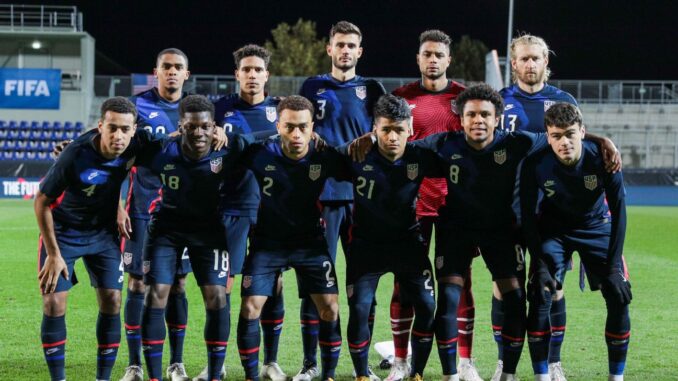
Since the failure of the US Men’s National Team to qualify for the 2018 World Cup, the US Soccer Federation has had one goal. To return to form as a team to be feared in CONCACAF. By doing so, in their minds, the team would also be in a prime spot to qualify for the 2022 World Cup in Qatar.
At the close of 2021, the United States now has more trophies in the cabinet and finds itself in 2nd place in the tournament to qualify for Qatar behind Canada. It’s been a lengthy process to get to this point, but 2021 was the culmination of a ton of effort by Brian McBride, Earnie Stewart, and Gregg Berhalter to attempt to be the best team in the region.
The first way they have done that has been the continued development of their young star players, mainly in the way it has reflected in the overall roster construction. Questions remain about prominent positions, precisely the problem at striker and who belongs on the right wing, but 9 of the 11 positions have either nailed on starters or a clear top two. If there was a game tomorrow, against Mexico, with a fully healthy player pool – fans can be fairly certain who is playing. Manchester City keeper Zack Steffen or New England Revolution Goaltender Matt Turner will be in the net, with a defensive four in front of him consisting of Barcelona’s Sergino Dest on the right, Atlanta United’s Miles Robinson, and Nashville FC’s Walker Zimmerman in the middle, and Fulham’s Antonee Robinson on the left. A midfield trio of RB Leipzig’s Tyler Adams, Juventus’ Weston Mckinnie, and Valencia’s Yunus Musah would be charged with patrolling the middle of the pitch. And somewhere up top, Chelsea’s Christian Pulisic will be wreaking havoc on opposing defenses with his insane dribbling skills. That is an insane amount of surety, given that before 2021, only a couple of those players had any amount of experience with the USMNT and barely had played together as a unit.
Miles Robinson and Zimmerman, in particular, were not seen as the guaranteed center back pairing. Whether that is because both ply their trade in the MLS, they are not the flashiest players or a combo of the two – both were looked over in favor of their European counterparts by a lot of the fanbase. Instead, they both inserted themselves in the line-up through superb play during 2021. Robinson bossed all of CONCACAF in the Gold Cup to win his spot, a tournament that Berhalter left a lot of the roster at home to rest up before qualifying. Robinson’s control and man-to-man defense made him a standout and was a huge reason the US (somewhat unexpectedly) won that tournament. Zimmerman only got his chance due to a last-second withdrawal of Wolfsburgs’ John Brooks in the October Qualifiers. Zimmerman was by far the strongest aerial defender in the first game against Jamaica and continued his strong play over the next three qualifiers. Together they are big, mobile, and strong. They have made the lives of opposing attackers miserable.
The midfield trio of Adams, Mckinnie, and Musah was less of a surprise and more like delayed gratification. The three play massive roles for massive teams in Europe, but before 2021 had only logged one game on the pitch together. The stars have seemed to align for this qualifying cycle, as the three have finally all had a spell of good health at the same time, which is fortunate, as their strengths blend together in such a beautiful way. Adams brings defensive bite, Mckinnie brings tireless hustle, and Musah is a star shuttler. Together they used their youth and athleticism to dominate the US’ first qualifier against Mexico, blanking the El Tri. They looked faster and hungrier against their more experienced rivals and finally fulfilled the promise that many had laid on this young US team. They will be the backbone for many, many games to come.
The other big unanswered question for many fans about this team was Gregg Berhalter’s coaching ability. From his hire in 2018 through 2020, there weren’t many games against good teams to judge Berhalter. A competitive loss to Mexico in the 2019 Gold Cup final and a split home-and-home with Canada in the Nations League stood as the benchmark, which left a lot of fans less than impressed. Those same fans will now have a harder time casting doubt on “Triple G,” considering he now has added two trophies to the hardware cabinet and sports a gaudy 3-0 record against Mexico in the last three meetings in three different scenarios (Nations League, Gold Cup, and WC Qualifying). A couple of weaker performances in qualifying, though, has stopped people from fully accepting him as a team savior, but he has indeed shown to be a real coach.
Outside of tactics, Berhalter has put his stamp on the team culture. The player pool is full of young and inexperienced players, and Gregg has leaned into a more laid-back coaching style. The sneak peeks in US Soccer’s “Behind the Shield” series and in press conferences there have been real highlights of joy, happiness, and friendship. There is a real feeling that the players really want to be there, not just out of duty to their country. That overall buy-in has really helped the team on the field, especially in rebounding after losses. For example, that home-and-home with Canada, where the US lost to the Maple Leafs for the first time in nearly 30 years, could’ve been a real blow to the confidence of a young team. Instead, the team walloped them at the next opportunity to the tune of a 4-1 victory – signifying who is the overall superior team. A lesser coach could have let doubt or nervousness leak into the team. Instead, Berhalter projected confidence – which allowed for a positive turnaround.
Berhalter’s handling of the media and allowing insights into his style of play has been a welcome change to previous coaches as well. It’s not a constant question mark of how the team will take the field. Instead, fans have confidence that they know what they’ll see when the game begins. It’s no secret that the 4-3-3 (4 defenders, 4 midfielders, 3 forwards) is the formation of choice, and Berhalter also drops nuggets both pre-and post-game about what the style of play will be for a specific match. While some could argue that laying these out in the open leaves the team at a tactical disadvantage, that hasn’t cropped up yet. Instead, keeping things secret is something that sank Jurgen Klinsmann late in his USMNT coaching career, as it constantly gave him an air of unsurety and cluelessness. This, combined with confidence in who will play, provides the team with an air of professionalism.
Unlike in 2018, the US has a coach to be confident in, a set roster, and a sure style of play. All this has led to the team currently sitting at second in WC qualifying with five qualifiers to go. If (knocking *very* hard on wood) the team keeps playing at its current level, they will have redeemed themselves to both the fan base and the world at large. While the US will not be considered a favorite if they do go ahead and qualify for the World Cup, they are now a unit that even the most storied teams will not be looking forward to playing. The US is a tidy side, with tough, young, athletic players who can beat anyone on any night. While the youth pipeline may one day deliver a super-team (Hello 2026 World Cup in the US!), right now, the fan base can breathe a sigh of relief that 2016 looked very much like a blip. The team is in steady hands, and the reward should be a return to playing soccer at the highest stages.



